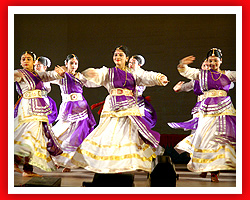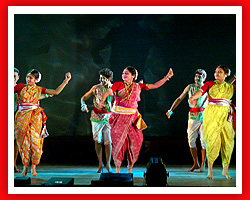Uday Shankar :: Amala Shankar

 This dance form traces
its origins to the the nomadic bards of ancient northern India, known as Kathaks, or story
tellers. These bards, performing in village squares and temple courtyards, mostly
specialized in recounting mythological and moral tales from the scriptures, and
embellished their recitals with hand gestures and facial ex-pressions. It was
quintessential theatre, using instrumental and vocal music along with stylized gestures,
to enliven the stories. With the advent of Mughal culture, Kathak became a sophisticated
chamber art. Patronized by art loving rulers, the practitioners of Kathak worked at
refining its dramatic and rhythmic aspects, delighting elite audiences with their mastery
over rhythm and the stylized mime. The technique of Kathak today is characterized by fast
rhythmic footwork set to complex time cycles. The footwork is matched by the accompanying
percussion instruments such as tabla and pakhawaj, and the dancer and percussionists often
indulge in a virtuoso display of rhythmic wizardry.The dance movements include numerous
pirouettes executed at lightning speed and ending in statuesque poses. The interpretative
portion, based on tales of Radha and Krishna and other mythological lore, contains subtle
gestures and facial ex-pressions. Lucknow, Banaras and Jaipur are recognized as the three
schools, or gharanas, where this art was nurtured and where the interpretative and
rhythmic aspects were refined to a high standard. This dance form traces
its origins to the the nomadic bards of ancient northern India, known as Kathaks, or story
tellers. These bards, performing in village squares and temple courtyards, mostly
specialized in recounting mythological and moral tales from the scriptures, and
embellished their recitals with hand gestures and facial ex-pressions. It was
quintessential theatre, using instrumental and vocal music along with stylized gestures,
to enliven the stories. With the advent of Mughal culture, Kathak became a sophisticated
chamber art. Patronized by art loving rulers, the practitioners of Kathak worked at
refining its dramatic and rhythmic aspects, delighting elite audiences with their mastery
over rhythm and the stylized mime. The technique of Kathak today is characterized by fast
rhythmic footwork set to complex time cycles. The footwork is matched by the accompanying
percussion instruments such as tabla and pakhawaj, and the dancer and percussionists often
indulge in a virtuoso display of rhythmic wizardry.The dance movements include numerous
pirouettes executed at lightning speed and ending in statuesque poses. The interpretative
portion, based on tales of Radha and Krishna and other mythological lore, contains subtle
gestures and facial ex-pressions. Lucknow, Banaras and Jaipur are recognized as the three
schools, or gharanas, where this art was nurtured and where the interpretative and
rhythmic aspects were refined to a high standard.

 In India, dance is an age-old tradition. This vast sub-continent has
given birth to varied forms of dancing, each shaped by the influences of a particular
period and environment. All Indian dances portray some ex-pression of life and almost
every dance posture has a specific meaning. Different states in India has different and
colourful folk dances. In India, dance is an age-old tradition. This vast sub-continent has
given birth to varied forms of dancing, each shaped by the influences of a particular
period and environment. All Indian dances portray some ex-pression of life and almost
every dance posture has a specific meaning. Different states in India has different and
colourful folk dances.

"THIS IS NOTHING BUT A 'GHARANA'
OF CREATIVITY".
Modern Dance in India has
a relatively short history. Since the perception of 'modern' or 'contemporary' can vary
from dancer to dancer, this dance form cannot be defined as easily as the classical dance
styles of India. It is also not codified in a detailed manner, as are the classical
styles. Uday Shankar, who was born in the early years of the 20th century, is widely
accepted as the Father of Modern Dance in India. This great dancer had a very wide vision,
and he appreciated the wonderful variety and scope of ex-pression afforded by the
different classical and folk dances extant in the country.
His search for a personal
ex-pression led him to incorporate different dance styles, such as Bharata Natyam and
Kathakali into his choreographic productions. He established an idyllic institution in the
hills of Kumaon, where he invited teachers from different genres to train his troupe in
order to groom their bodies to a state where they could produce a varied, rich and
contemporary dance vocabulary. Uday Shankar was an idealist as well as a wonderful
showman.
He was a catalyst in the
renaissance of interest in Indian arts during the 1930s and '40s, and he introduced
audiences in the West to Indian dance and music through the performances of his troupe and
which was widely known as 'HINDU DANCE'. Some of Uday Shankar's famous works include the
innovative ballet, 'Labour and Machinery' and a path breaking film, 'Kalpana,' on the
theme of dance.
The institute established
by Uday Shankar is now defunct, but his legacy survives in the work of his children and
his many disciples, who have their own troupes and students. Today, in addition to the
line established by Uday Shankar, there are other practitioners of Modern Dance in India
who belong to other schools. |